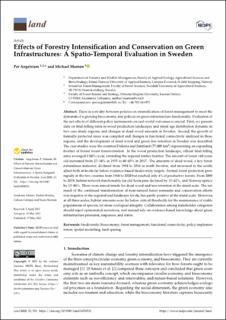Effects of forestry intensification and conservation on green infrastructures: A spatio-temporal evaluation in Sweden
Peer reviewed, Journal article
Published version
Permanent lenke
https://hdl.handle.net/11250/3000050Utgivelsesdato
2021Metadata
Vis full innførselSamlinger
Sammendrag
There is a rivalry between policies on intensification of forest management to meet the demands of a growing bioeconomy, and policies on green infrastructure functionality. Evaluation of the net effects of different policy instruments on real-world outcomes is crucial. First, we present data on final felling rates in wood production landscapes and stand age distribution dynamic in two case study regions, and changes in dead wood amounts in Sweden. Second, the growth of formally protected areas was compiled and changes in functional connectivity analysed in these regions, and the development of dead wood and green tree retention in Sweden was described. The case studies were the counties Dalarna and Jämtland (77,000 km2 ) representing an expanding frontier of boreal forest transformation. In the wood production landscape, official final felling rates averaged 0.84%/year, extending the regional timber frontier. The amount of forest <60 years old increased from 27–34% in 1955 to 60–65% in 2017. The amounts of dead wood, a key forest naturalness indicator, declined from 1994 to 2016 in north Sweden, and increased in the south, albeit both at levels far below evidence-based biodiversity targets. Formal forest protection grew rapidly in the two counties from 1968 to 2020 but reached only 4% of productive forests. From 2000 to 2019, habitat network functionality for old Scots pine declined by 15–41%, and Norway spruce by 15–88%. There were mixed trends for dead wood and tree retention at the stand scale. The net result of the continued transformation of near-natural forest remnants and conservation efforts was negative at the regional and landscape levels, but partly positive at the stand scale. However, at all three scales, habitat amounts were far below critical thresholds for the maintenance of viable populations of species, let alone ecological integrity. Collaboration among stakeholder categories should reject opinionated narratives, and instead rely on evidence-based knowledge about green infrastructure pressures, responses, and states.

